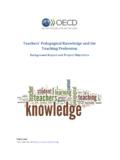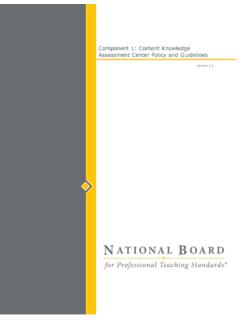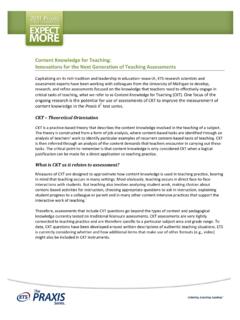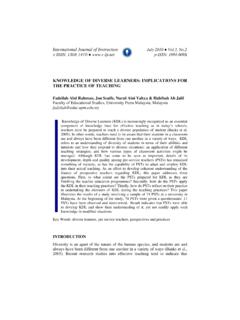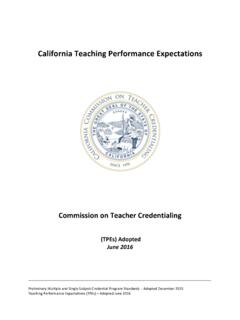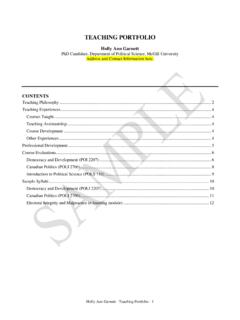Transcription of Teaching place-value - ed
1 35 APMC 23(3) 2018 Judy HartnettMaking Maths place-value : Concept development, big ideas and activitiesIntroductionWorking as a mathematics education consultant in schools, both as a system-based advisor and private consultant, I am regularly asked to support teachers to work with students who do not understand place value. As reported by other researchers including Rogers (2013), I, too, am regularly dismayed at the superficial under-standing so many primary students exhibit in relation to place value. I have also observed repeated amazement by teachers when I demonstrate lessons, or discuss the big ideas relating to place value in comments such as I have never thought about it that way.
2 Primary school teachers teach a number of subjects, and while they continue to learn and access professional development, it is not surprising that they do not have an indepth understanding of the many concepts that underpin mathematical topics such as place value. This paper outlines the development of a list of concepts I hope will support teachers to develop their knowledge of this topic to help them plan and present lessons to assist their students to understand the knowledgesResearch has recognised that teachers require a range of types of knowledge . Shulman (1986) described seven types of teacher knowledge : knowledge of content , general pedagogical knowledge , curriculum knowledge , pedagogical content knowledge , knowledge of students, knowledge of educational contexts and knowledge of educational ends, purposes and values.
3 Based on the work of Shulman and colleagues ( , Shulman & Grossman, 1988), Borko and Putnam (1995) proposed a model of teacher knowledge organised around three domains of knowledge : general pedagogical knowledge , subject matter knowledge and pedagogical content knowledge . Table 1 outlines these domains and their 1. Domains and components of the knowledge base of Teaching (Borko & Putnam, 1995).DomainsComponentsGeneral pedagogical knowledge Learning environments and instructional strategies Classroom management knowledge of learners and learningSubject matter knowledge knowledge of content and substantive structures Syntactic structuresPedagogical content knowledge Overarching conception of Teaching a subject knowledge of instructional strategies and representations knowledge of students understandings and potential misunderstandings knowledge of curriculum and curricular materialsTeachers I had been supporting appeared to lack mathematical subject matter knowledge , and also wel-comed suggestions about pedagogical content knowl-edge.
4 Teachers have access to Australian Curriculum documents and often commercial maths programs and resources. These documents provide descriptions, glossaries and activities but lack the mathematical depth to help the teachers develop their subject matter knowledge . A sequential list of big ideas and concepts that under-pin mathematics could be a valuable support for teachers. Table 2 provides an example of how several concepts can underpin one Australian Curriculum description. I started to draft such lists for mathematics topics in a number of areas about which I had received requests for assistance, including place paper was originally presented at the 25th Biennial Conference of AAMT, Capital Maths , and published in the Conference Proceedings.
5 The author discusses the development and beginning implementation of a detailed sequence of concepts, with the intention of support-ing teachers to support students to understand place 23(23) 2018 Big ideasPlace value is not a single concept. Schmittau and Vagliardo (2006) used concept mapping to describe place value as a complex system. Price (1998) described how the development of connected memory structures or schema can assist students to understand complex numeration concepts like place value. He described how assisting students to develop powerful schemas to understand the complexities of place value was attractive to mathematics educators but commented that for many students such schemas had not developed.
6 My anecdotal observations led me to suspect that many of the teachers I was supporting may not have developed a rich schema for a deep understanding of our base-ten number system themselves. This lack of subject knowl-edge would likely inhibit their ability to design learning activities and identify common misconceptions in their researchers have identified concepts that need to be understood for students to become place value experts (Rogers, 2012; Ross 1989). Rogers (2012) conducted a comprehensive search of literature on the topic and focussed on the work of Rubin and Russell (1992) and Ross (2002) to identify seven components of place value. Rogers noted that there is no develop-mental order implied in the list: Count: Counting forwards and backwards in place value parts ( , 45, 55, 65 is counting using the unit ten).
7 Bridging forwards and backwards over place value segments ( , 995 and one more ten requires bridging forwards over hundreds to thousands). Make/represent: Make, represent or identify the value of a number using a range of materials or models these may be proportional, non- proportional, canonical and non-canonical. Name/record: Read and write a number in words and figures ( , 75 is written as seventy- five ). Identify the value of digits in a number ( , the value of 3 in 345 is three hundreds). Rounding numbers to the nearest place value part ( , round 2456 to the nearest thousand). Rename: Recognise and complete partitions and regrouping of numbers. ( ,1260 has 126 tens). Compare/order: Compare numbers to deter-mine which is larger or smaller and place them in descending or ascending order.
8 Calculate: Apply knowledge of place value when completing calculations ( , 45 by 10 is 45 tens) Estimate: Use knowledge of magnitude of num-bers when estimating ( , estimate how many oranges fill a classroom: 10? 100? 100 000?)Other authors have identified concepts relating to place value which theoretically fit within the compo-nents above. Examples include the Odometer Principle (YuMi Deadly Centre, 2014) which states that in any place-value position, numbers count the same as in the ones place, counting forwards from 0 to 9 and then back to 0 with the digit to the left increased by 1; the recursive HTO pattern (Siemon, Beswick, Brady, Clark, Farragher & Warren, 2011); composite units/super-unitising and sub-unitising (Siemon et al.)
9 , 2011, Baturo, 1998); and the recursive multiplicative relationship between the places where 10 of these is one of those (Siemon et al., p. 302). Place value is a complex mathematical topic with a multitude of big ideas and connected concepts to be understood. A list of these big ideas of place value would need to include all these big ideas presented in a way that made sense to developmentWhen learning mathematics, students progress through topics and associated concepts which get increasingly more sophisticated. This educative progression has been identified as back as far as Piaget (1952). Carpenter and Fennema (1991) noted that teachers need an understand-ing of the stages students move through when developing concepts and procedures.
10 The Queensland University of Technology (QUT) YuMi Deadly Centre (2014) stated that it is essential for teachers to know what mathematics precedes, relates to and follows what they are Teaching (p. 2). Recent studies in Australia have used this idea to identify learning progressions; , Growth Points (Clarke et al., 2002) and Learning Assessment Frameworks (Siemon, Izard, Breed & Virgona, 2006).The idea of a list of the progression of concepts for place value as a Teaching tool appealed to me as a way of supporting teachers who lacked subject matter knowledge of this topic. I began to draft a conceptual development list for place value based on ideas and concepts gathered over many years working with teachers, researching in mathematics education and working with other research-ers.










